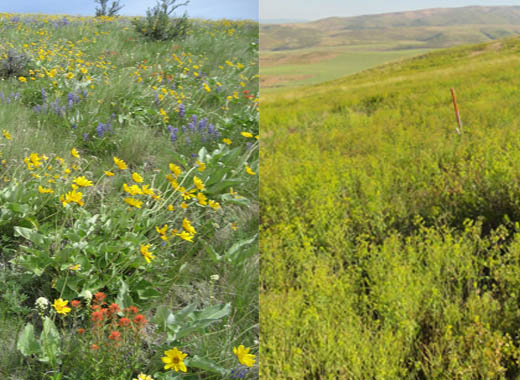
MPG Ranch Joins the Earth Microbiome Project
Block title
 By: Ylva LekbergPh.D. Ecologist
By: Ylva LekbergPh.D. EcologistMillions of acres of grasslands in the Western United States remain invaded by the Eurasian weeds, in spite of interventions including herbicide applications, biological control agents, and changes in managements. Restoration efforts rarely re-establish complex native communities, most likely is due to invasion-mediated shifts in soil microbial communities and ecosystem processes.

Figure caption: A diverse native community and a leafy spurge invasion on the MPG Ranch. While the aboveground shifts in plant communities are easily appreciated, invasion-mediated shifts in belowground microbial communities and ecosystem processes are less known, but could be driving subsequent invasions and influence restoration success.
Photo credits: Chris Gallagher and Lauren Stoffel.
MPG Ranch recently joined the EMP (http://www.earthmicrobiome.org/) to characterize potential shifts in soil microbial communities associated with knapweed, cheatgrass and leafy spurge invasions. We are excited to assist with EMP’s goal to characterize global microbial taxonomic and functional diversity. This collaboration will allow us to assess how the invasion-mediated simplification of plant communities influences soil microbial function and diversity, and identify the relationship between microbial community composition and ecosystem function. The overall goal is to utilize this knowledge to develop better restoration practices that set invaded communities on trajectories towards diverse native communities.

About the AuthorYlva Lekberg
Ylva graduated from the Swedish University of Agricultural Sciences with a M.Sc. in Biology and Horticulture in 1996 and a Ph.D. in Ecology from Penn State University in 2004. She received the Alumni Association Dissertation Award for her work in agroecology and subsistence farming in Sub-Saharan Africa. Post-doctoral positions at Montana State University and later at Copenhagen University as a Marie Curie Fellow allowed her to explore the role of arbuscular mycorrhiza, a root-fungus symbiosis, for geothermal plants in Yellowstone National Park and coastal grasslands in Denmark. Her research has been published in international journals such as Nature Communications, Ecology Letters, and New Phytologist.
Ylva joined MPG Ranch in 2010. Since then, she has explored how invasive plants common to western Montana, including spotted knapweed (Centaurea stoebe), leafy spurge (Euphorbia esula) and cheatgrass (Bromus tectorum), influence soil microbial community composition and function, and how this in turn may affect invasive success. A lot of her research also focuses on the AM symbiosis in terms of community ecology and physiology. A current project addresses how exchange ratios in this symbiosis may differ among co-occurring plants and depend on soil nutrient availabilities. She uses surveys, field and greenhouse experiments, and literature approaches such as meta-analyses to address questions. To learn more about research and publications from Ylva and her group, see CV below and the Soils, Plants and Invasion section.
In addition to her work at MPG Ranch, Ylva is an adjunct professor at University of Montana at the Department of Ecosystem and Conservation Sciences.
Ylva joined MPG Ranch in 2010. Since then, she has explored how invasive plants common to western Montana, including spotted knapweed (Centaurea stoebe), leafy spurge (Euphorbia esula) and cheatgrass (Bromus tectorum), influence soil microbial community composition and function, and how this in turn may affect invasive success. A lot of her research also focuses on the AM symbiosis in terms of community ecology and physiology. A current project addresses how exchange ratios in this symbiosis may differ among co-occurring plants and depend on soil nutrient availabilities. She uses surveys, field and greenhouse experiments, and literature approaches such as meta-analyses to address questions. To learn more about research and publications from Ylva and her group, see CV below and the Soils, Plants and Invasion section.
In addition to her work at MPG Ranch, Ylva is an adjunct professor at University of Montana at the Department of Ecosystem and Conservation Sciences.



















